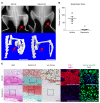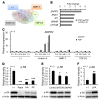Activin-A enhances mTOR signaling to promote aberrant chondrogenesis in fibrodysplasia ossificans progressiva
- PMID: 28758906
- PMCID: PMC5669572
- DOI: 10.1172/JCI93521
Activin-A enhances mTOR signaling to promote aberrant chondrogenesis in fibrodysplasia ossificans progressiva
Abstract
Fibrodysplasia ossificans progressiva (FOP) is a rare and intractable disease characterized by extraskeletal bone formation through endochondral ossification. Patients with FOP harbor point mutations in ACVR1, a type I receptor for BMPs. Although mutated ACVR1 (FOP-ACVR1) has been shown to render hyperactivity in BMP signaling, we and others have uncovered a mechanism by which FOP-ACVR1 mistransduces BMP signaling in response to Activin-A, a molecule that normally transduces TGF-β signaling. Although Activin-A evokes enhanced chondrogenesis in vitro and heterotopic ossification (HO) in vivo, the underlying mechanisms have yet to be revealed. To this end, we developed a high-throughput screening (HTS) system using FOP patient-derived induced pluripotent stem cells (FOP-iPSCs) to identify pivotal pathways in enhanced chondrogenesis that are initiated by Activin-A. In a screen of 6,809 small-molecule compounds, we identified mTOR signaling as a critical pathway for the aberrant chondrogenesis of mesenchymal stromal cells derived from FOP-iPSCs (FOP-iMSCs). Two different HO mouse models, an FOP model mouse expressing FOP-ACVR1 and an FOP-iPSC-based HO model mouse, revealed critical roles for mTOR signaling in vivo. Moreover, we identified ENPP2, an enzyme that generates lysophosphatidic acid, as a linker of FOP-ACVR1 and mTOR signaling in chondrogenesis. These results uncovered the crucial role of the Activin-A/FOP-ACVR1/ENPP2/mTOR axis in FOP pathogenesis.
Conflict of interest statement
Figures







Similar articles
-
Neofunction of ACVR1 in fibrodysplasia ossificans progressiva.Proc Natl Acad Sci U S A. 2015 Dec 15;112(50):15438-43. doi: 10.1073/pnas.1510540112. Epub 2015 Nov 30. Proc Natl Acad Sci U S A. 2015. PMID: 26621707 Free PMC article.
-
An mTOR Signaling Modulator Suppressed Heterotopic Ossification of Fibrodysplasia Ossificans Progressiva.Stem Cell Reports. 2018 Nov 13;11(5):1106-1119. doi: 10.1016/j.stemcr.2018.10.007. Epub 2018 Nov 1. Stem Cell Reports. 2018. PMID: 30392977 Free PMC article.
-
The ACVR1 R206H mutation found in fibrodysplasia ossificans progressiva increases human induced pluripotent stem cell-derived endothelial cell formation and collagen production through BMP-mediated SMAD1/5/8 signaling.Stem Cell Res Ther. 2016 Aug 17;7(1):115. doi: 10.1186/s13287-016-0372-6. Stem Cell Res Ther. 2016. PMID: 27530160 Free PMC article.
-
The obligatory role of Activin A in the formation of heterotopic bone in Fibrodysplasia Ossificans Progressiva.Bone. 2018 Apr;109:210-217. doi: 10.1016/j.bone.2017.06.011. Epub 2017 Jun 16. Bone. 2018. PMID: 28629737 Free PMC article. Review.
-
How Activin A Became a Therapeutic Target in Fibrodysplasia Ossificans Progressiva.Biomolecules. 2024 Jan 12;14(1):101. doi: 10.3390/biom14010101. Biomolecules. 2024. PMID: 38254701 Free PMC article. Review.
Cited by
-
Fibrodysplasia ossificans progressiva: current concepts from bench to bedside.Dis Model Mech. 2020 Sep 21;13(9):dmm046441. doi: 10.1242/dmm.046441. Dis Model Mech. 2020. PMID: 32988985 Free PMC article. Review.
-
Inhibition of PI3K/AKT signaling pathway prevents blood-induced heterotopic ossification of the injured tendon.J Orthop Translat. 2024 Feb 2;44:139-154. doi: 10.1016/j.jot.2023.11.003. eCollection 2024 Jan. J Orthop Translat. 2024. PMID: 38328343 Free PMC article.
-
Bringing Induced Pluripotent Stem Cell Technology to the Bedside.JMA J. 2018 Sep 28;1(1):6-14. doi: 10.31662/jmaj.2018-0005. JMA J. 2018. PMID: 33748517 Free PMC article.
-
Molecular Developmental Biology of Fibrodysplasia Ossificans Progressiva: Measuring the Giant by Its Toe.Biomolecules. 2024 Aug 15;14(8):1009. doi: 10.3390/biom14081009. Biomolecules. 2024. PMID: 39199396 Free PMC article. Review.
-
Application of mesenchymal stem cells derived from human pluripotent stem cells in regenerative medicine.World J Stem Cells. 2021 Dec 26;13(12):1826-1844. doi: 10.4252/wjsc.v13.i12.1826. World J Stem Cells. 2021. PMID: 35069985 Free PMC article. Review.
References
-
- Kaplan F, et al. The phenotype of fibrodysplasia ossificans progressiva. Clinic Rev Bone Miner Metab. 2005;3(3-4):183–188. doi: 10.1385/BMM:3:3-4:183. - DOI
-
- Shore E, Feldman G, Xu M, Kaplan F. The genetics of fibrodysplasia ossificans progressiva. Clinic Rev Bone Miner Metab. 2005;3(346):201–204. - PubMed
MeSH terms
Substances
LinkOut - more resources
Full Text Sources
Other Literature Sources
Molecular Biology Databases
Miscellaneous

